A wind farm can alter radar signals that are 10 to 20 kilometers away. Now a Spanish software program called ‘Sopcawind’ is helping to prevent such problems from taking place during the design phase of these facilities.
A group from the University of the Basque Country (UPV/EHU according to its abbreviations in Spanish and Basque) is helping to develop a tool to be used in the design of wind farms, which not only considers energy productivity, but also evaluates the possible environmental impact that a farm might have on radar and other communications systems.
The Spanish software program ‘Sopcawind’ is aimed at avoiding possible communications interference, given that wind farms can alter radar signals that are 10 to 20 kilometers away. UPV/EHU’s Signal Treatment and Radiocommunication group (TSR in Spanish) represented the University in this project.
Designing a wind farm is a process that involves numerous factors. The key component is the available wind and generation potential. But beyond this, engineers also have to take into account telecommunications services: meteorological radars, air traffic control radars, radio navigation systems, television and data communications systems.
Through field observations, the research group has analyzed the signal emitted by the wind turbines in the UHF band and evaluated its impact on the quality of television signals. The results of this study were presented to the International Telecommunication Union (ITU)—the international telecommunications regulatory authority—and included in the evaluation process for a new set of recommendations. Once this process is successfully completed the results of the research carried out by the UPV/EHU will become part of international regulations for this sector.
